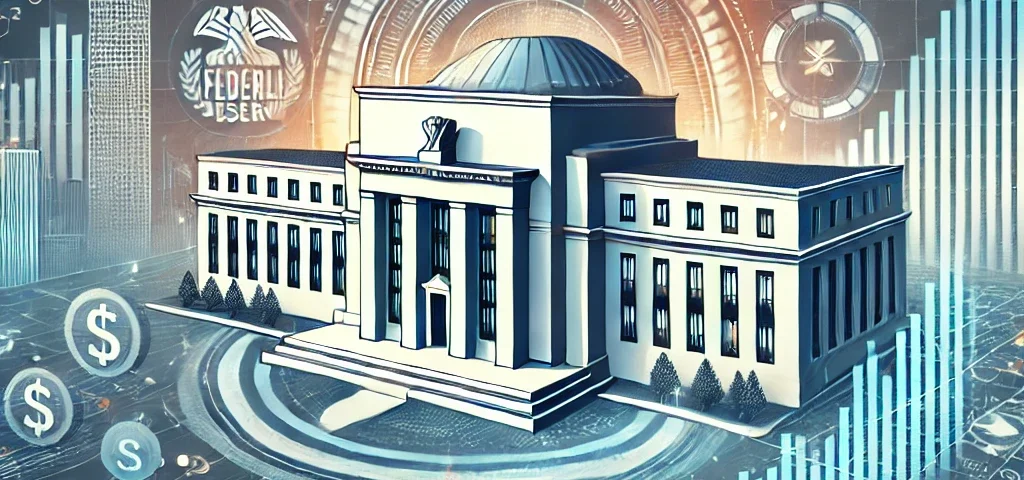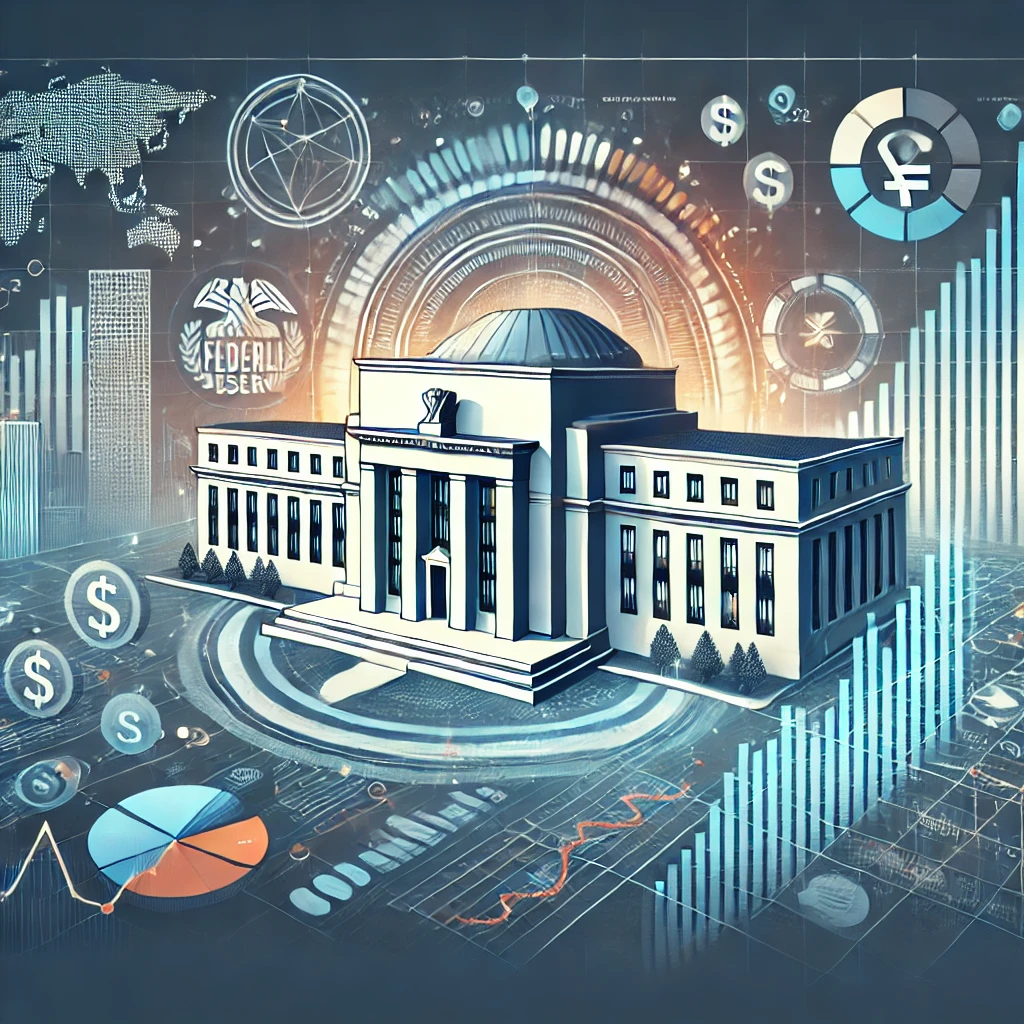
The Impact of Interest Rates on Stocks
14/10/2024
How to Create an Investment Plan
16/10/2024Understanding the Federal Reserve: The Powerhouse Behind Economic Stability and Global Financial Markets

Understanding the Federal Reserve: The Powerhouse Behind Economic Stability and Global Financial Markets
Understanding the Federal Reserve: The Powerhouse Behind Economic Stability and Global Financial Markets
The Federal Reserve, often referred to as “the Fed,” is the central bank of the United States and one of the most influential financial institutions in the world. Established in 1913, the Fed is responsible for overseeing and regulating the U.S. monetary and financial system. Its primary goals are to promote economic stability, control inflation, and maintain a healthy labor market. In this article, we will explore what the Federal Reserve is, how it operates, and why it plays a crucial role in the global economy.

What is the Federal Reserve?
The Federal Reserve is an independent central bank created by the U.S. Congress through the Federal Reserve Act of 1913. It was established in response to a series of financial panics and banking crises in the early 20th century, with the goal of providing the country with a safer, more flexible, and more stable monetary and financial system.
Structure of the Federal Reserve
The Federal Reserve system is made up of several key components:
- Board of Governors: The Board of Governors is based in Washington, D.C., and consists of seven members who are appointed by the U.S. President and confirmed by the Senate. The Board oversees the entire Federal Reserve system and plays a major role in setting monetary policy.
- Federal Open Market Committee (FOMC): The FOMC is the branch of the Federal Reserve responsible for setting U.S. monetary policy, particularly through open market operations. It includes the Board of Governors and five regional Federal Reserve Bank presidents.
- 12 Regional Federal Reserve Banks: The Federal Reserve system is divided into 12 regions, each with its own regional Federal Reserve Bank. These banks serve as the operational arms of the Fed, implementing monetary policy, supervising and regulating financial institutions, and providing financial services to the government.
- Member Banks: Many commercial banks in the U.S. are members of the Federal Reserve system. These banks hold stock in their regional Federal Reserve Bank and benefit from the Fed’s services.
Functions of the Federal Reserve
The Federal Reserve has several key responsibilities that help promote a stable and healthy U.S. economy:
1. Monetary Policy
One of the Fed’s primary functions is to control monetary policy, which involves managing the supply of money and interest rates to achieve macroeconomic goals. The Federal Reserve influences the economy by raising or lowering the federal funds rate, which is the interest rate banks charge each other for overnight loans.
- Lowering Interest Rates: When the Fed lowers interest rates, borrowing becomes cheaper, which encourages spending and investment. This can help stimulate economic growth during times of recession or economic downturn.
- Raising Interest Rates: Conversely, when the Fed raises interest rates, borrowing becomes more expensive. This can slow down inflation and prevent the economy from overheating.
The Fed also uses open market operations, such as buying or selling government securities, to influence liquidity in the banking system.
2. Supervision and Regulation
The Federal Reserve is responsible for supervising and regulating banks and financial institutions to ensure the safety and soundness of the financial system. It conducts regular audits and stress tests to ensure that banks are operating in a safe and sound manner. The Fed also enforces consumer protection laws, ensuring that consumers are treated fairly by financial institutions.
3. Maintaining Financial Stability
The Fed plays a key role in maintaining the stability of the U.S. financial system. It monitors risks in the financial markets and can act as a lender of last resort during financial crises. For example, during the 2008 financial crisis, the Fed provided emergency loans to banks and other financial institutions to prevent them from collapsing and causing further damage to the economy.
4. Providing Financial Services
The Federal Reserve provides various financial services to the U.S. government, financial institutions, and foreign entities. It manages the nation’s payments system, processes electronic payments, and oversees the distribution of currency and coins.
Why is the Federal Reserve Important?
The Federal Reserve is crucial to the functioning of the U.S. economy and the global financial system for several reasons:
1. Influence on Interest Rates and Economic Activity
One of the most important roles of the Federal Reserve is setting interest rates. By adjusting the federal funds rate, the Fed can influence borrowing and spending decisions by businesses and consumers. Lower interest rates generally stimulate economic activity by making borrowing cheaper, while higher interest rates help curb inflation by reducing spending.
The Fed’s ability to control interest rates has a direct impact on areas such as:
- Home Loans: When the Fed lowers interest rates, mortgage rates tend to decrease, making home loans more affordable.
- Consumer Spending: Lower rates can encourage consumers to take out loans or use credit, boosting spending in the economy.
- Business Investment: With lower borrowing costs, businesses are more likely to invest in expansion, research, and hiring.
- Inflation Control: By raising rates, the Fed can help slow inflation by reducing the amount of money circulating in the economy.
2. Stabilizing the Financial System
The Federal Reserve plays a crucial role in maintaining financial stability, especially during times of economic stress or financial crises. For example, during the 2008 financial crisis and the COVID-19 pandemic, the Fed took decisive action to stabilize the economy by injecting liquidity into the financial system, lowering interest rates, and purchasing government bonds to support economic recovery.
The Fed’s role as a lender of last resort ensures that banks and financial institutions can continue to operate during crises, which helps prevent widespread bank failures and economic collapse.
3. Managing Inflation
Inflation is a critical factor that affects the cost of goods and services in the economy. If inflation rises too quickly, it can erode purchasing power and create economic instability. The Federal Reserve uses monetary policy tools, such as interest rates and open market operations, to keep inflation within a target range (usually around 2%).
By controlling inflation, the Fed helps to maintain the purchasing power of the U.S. dollar and promote stable economic growth.
4. Impact on Global Financial Markets
As the central bank of the largest economy in the world, the Federal Reserve’s decisions have a significant impact on global financial markets. Changes in U.S. interest rates can influence currency exchange rates, global stock markets, and international capital flows.
For example, when the Fed raises interest rates, it can make the U.S. dollar stronger relative to other currencies, which affects global trade and investment. Similarly, when the Fed provides liquidity during times of crisis, it can help stabilize not only the U.S. economy but also the global financial system.
5. Confidence in the Economy
The Federal Reserve plays a key role in instilling confidence in the economy. By maintaining stable prices, promoting full employment, and acting as a backstop during financial crises, the Fed helps to create an environment of trust and stability that encourages investment and economic growth.
Conclusion
The Federal Reserve is the cornerstone of the U.S. financial system, with its influence extending far beyond national borders. Through its control of monetary policy, regulation of financial institutions, and management of the money supply, the Fed plays a pivotal role in shaping economic outcomes in the U.S. and around the world. Its ability to navigate complex economic challenges, promote financial stability, and influence interest rates makes the Federal Reserve one of the most important institutions in the global economy.
As we continue to see rapid changes in the financial landscape, the Fed’s role will remain central to ensuring the stability and growth of both the U.S. economy and the global financial system.
Top 10 U.S. Stocks: History, Growth Factors, Risks, and Optimal Buying Times


